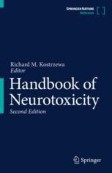Search
Search Results
-
6-Hydroxydopa: A Precursor-Neurotoxin with Relative Selectivity for Noradrenergic Neurons
The selective neurotoxin 6-hydroxydopa (6-OHDOPA) was developed because of the correct assumption that it could, with some advantage, replicate...
-
6-Hydroxydopa: A Precursor-Neurotoxin with Relative Selectivity for Noradrenergic Neurons
The selective neurotoxin 6-hydroxydopa (6-OHDOPA) was developed because of the correct assumption that it could, with some advantage, replicate...
-
Association of tyrosine hydroxylase expression in brain and tumor with increased tumor growth in sympathectomized mice
ObjectiveLymphocytes express tyrosine hydroxylase (TH), the rate-limiting enzyme for the synthesis of dopamine, norepinephrine and epinephrine. This...

-
Phytonutraceuticals Modulate Cell Survival Signaling and Regulate Sympathetic Innervation in Aging and Disease
As individual's age, they experience an upsurge in cellular oxidative stress levels, autophagy, and chronic inflammation, resulting in several...
-
Effects of Low-Dose L-Thyroxine on Stress Resistance in Animals with Experimental Deficit of Sympathetic Neural Influences
Moderate increases in catecholamine levels have adaptive effects in stress. The thyroid axis has also been shown to have a role in adaptation to...
-
The Antinociceptive Effect of Sympathetic Block is Mediated by Transforming Growth Factor β in a Mouse Model of Radiculopathy
Although sympathetic blockade is clinically used to treat pain, the underlying mechanisms remain unclear. We developed a localized microsympathectomy...

-
The Hepatic Nerves Regulated Inflammatory Effect in the Process of Liver Injury: Is Nerve the Key Treating Target for Liver Inflammation?
Liver injury is a common pathological basis for various liver diseases. Chronic liver injury is often an important initiating factor in liver...

-
Botulinum Toxin Therapy for Neuropathic Pain (NP)
Neuropathic pain (NP) arises from irritation or damage of nociceptive nerve fibers or nociceptive neurons. It is a common form of pain, often poorly...
-
Botulinum Toxin Therapy for Autonomic Dysfunction (Excessive Drooling/Sialorrhea and Excessive Sweating (Hyperhidrosis) and for Certain Skin Disorders
Injection of botulinum toxins to the glands reduces the secretion of saliva or sweat by blocking the release of nerve signal transmitter...
-
K Channel Openers as New Antiarrhythmic Agents
Cardiac cation channels are membrane proteins that provide controlled ion passage through cellular membranes to allow electrical control of the...
-
Survey of Selective Monoaminergic Neurotoxins Targeting Dopaminergic, Noradrenergic, and Serotoninergic Neurons
The concept of selective neurotoxicity was highlighted in the 1930s by the noted Physiologist Walter Canon who promoted the concept of “absence...
-
Survey of Selective Monoaminergic Neurotoxins Targeting Dopaminergic, Noradrenergic, and Serotoninergic Neurons
The concept of selective neurotoxicity was highlighted in the 1930s by the noted Physiologist Walter Canon who promoted the concept of “absence...
-
Systemic Onco-Sphere: Host Neuronal System in Cancer
In human, the nervous system governs vital functional activities of many organs. As tumor is a systemic disease, it does not grow as an independent...
-
Somatosensory and autonomic neuronal regulation of the immune response
Bidirectional communication between the peripheral nervous system (PNS) and the immune system is a crucial part of an effective but balanced...

-
Cancer Induced Remodeling of the Peripheral Nervous System
The presence of nerves in peripheral malignancies is now widely accepted. As our understanding of the recruitment and functions of these...
-
Antibody-mediated inhibition of GDF15–GFRAL activity reverses cancer cachexia in mice
Cancer cachexia is a highly prevalent condition associated with poor quality of life and reduced survival
1 . Tumor-induced perturbations in the...
-
The role of beta-adrenoreceptors in postoperative ileus in rats
The aim of the research was to evaluate the influence of antagonists of specific beta-adrenergic receptor subtypes on bowel motility following...

-
Loss of intestinal sympathetic innervation elicits an innate immune driven colitis
BackgroundBoth the parasympathetic and sympathetic nervous system exert control over innate immune responses. In inflammatory bowel disease,...

-
Neurovascular coupling in bone regeneration
The mammalian skeletal system is densely innervated by both neural and vascular networks. Peripheral nerves in the skeleton include sensory and...
-
Enteric Control of the Sympathetic Nervous System
The autonomic nervous system that regulates the gut is divided into sympathetic (SNS), parasympathetic (PNS), and enteric nervous systems (ENS). They...
